rims AUDI A5 COUPE 2013 Owners Manual
[x] Cancel search | Manufacturer: AUDI, Model Year: 2013, Model line: A5 COUPE, Model: AUDI A5 COUPE 2013Pages: 294, PDF Size: 73.84 MB
Page 207 of 294
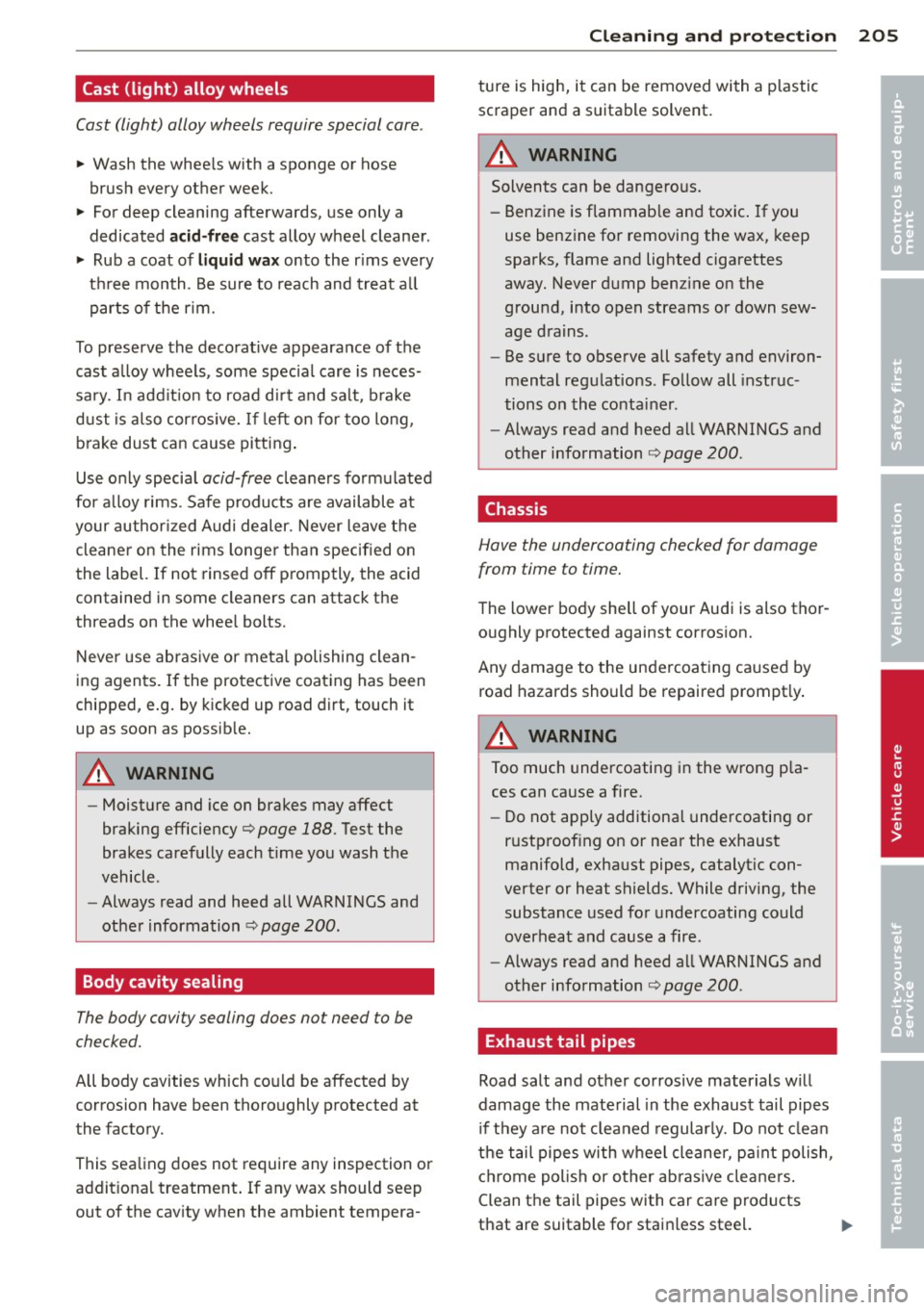
Cast (light) alloy wheels
Cast (light) alloy wheels require special care.
~ Wash the wheels with a sponge or hose
brush every other week.
~ For deep cleaning afterwards, use only a
dedicated
aci d-fr ee cast alloy wheel cleaner.
~ Rub a coat of liqui d wax onto the r ims every
t hr ee month. Be sure to reach and treat a ll
parts of the r im.
To preserve the decorat ive appearance of the
cast alloy whee ls, some special care is neces
sary. I n add it ion to road d ir t and sa lt, b rake
dust is a lso cor ros ive. If left on for too long,
b rake dus t ca n cause pitting.
Use only specia l
acid-free cleaners formulated
fo r alloy rims. Safe products are available at
your author ized Audi dealer. Never leave the
cleane r on the rims longer than specif ied on
the label. If not rinsed
off promptly, the acid
contained in some cleaners can attack the
threads on the whee l bolts.
Never use abras ive or metal polishing clean
ing agents.
If the protective coating has been
chipped, e .g. by kicked up road dirt, touch it
up as soon as possib le.
A WARNING
- Moisture and ice on brakes may affect
braking efficiency
q page 188. Test the
brakes carefully each time you wash the
vehicle .
- Always read and heed all WARNINGS and
other information
q page 200.
Body cavity sealing
-
The body cavity sealing does not need to be
checked.
All body cavities which co uld be affected by
corrosion have been thoro ughly protected at
the factory.
This sea ling does not require any inspection or
addit ional treatment . If any wax should seep
out of the cav ity when the ambient tempera-
Cleaning and protec tion 205
ture is high, it can be removed with a p lastic
scraper and a suitable solvent.
A WARNING
Solvents can be dangerous.
- Benzine is flammab le and toxic. If you
use benzine fo r removing the wax, keep
sparks, flame and lighted cigarettes
away. Never dump benz ine on the
ground, i nto open streams or down sew
age drains.
- Be sure to observe all safety and environ
mental regulations. Follow all instruc
tions on the container.
- Always read a nd heed all WARNINGS and
other information
q page 200.
Chassis
Have the undercoating checked for damage
from time to time.
The lower body she ll of your Audi is also thor
oughly protected against corros ion.
Any damage to the unde rcoat ing caused by
road hazards sho uld be repaired prompt ly .
A WARNING
Too much undercoating i n the wrong p la
ces can cause a fire.
- Do not apply additiona l undercoating or
r u stproof ing on or near the exhaust
manifold, exhaust pipes, catalytic con
verter or heat shields. While driving, the substance used fo r undercoating could
overheat and cause a fire.
- Always read and heed all WARNINGS and
other information
q page 200.
Exhaust tail pipes
Road salt and other co rrosive materials w ill
damage the mate rial in the exhaust tail pipes
i f th ey a re not clea ned regularly. Do not clea n
the tail pipes with wheel cleane r, pa int polish,
c h rome pol ish or o ther ab ras ive cleane rs .
Clean the tail pipes with ca r care products
that are suitable fo r stainless steel. •
•
Page 233 of 294
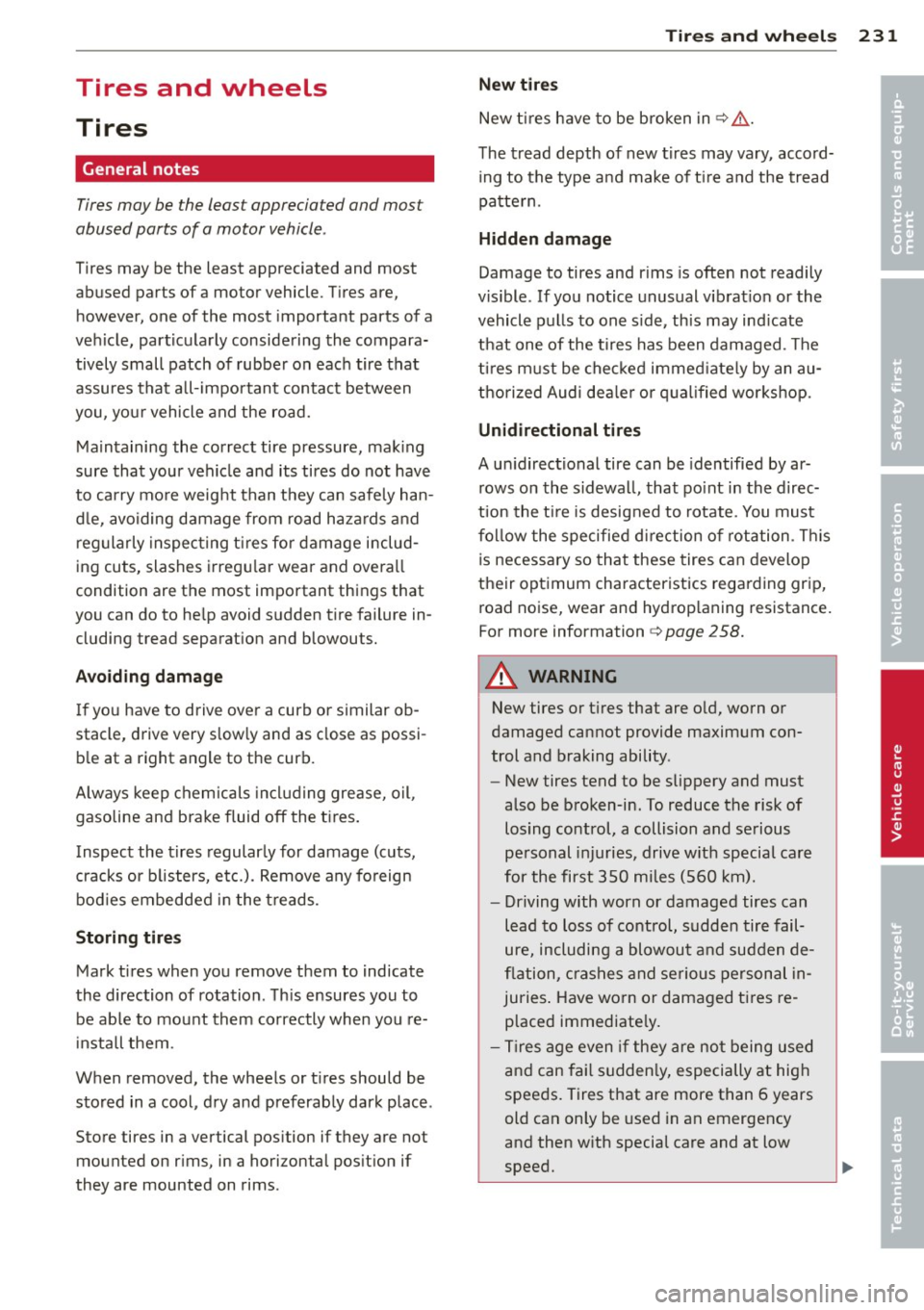
Tires and wheels
Tires
General notes
Tires may be the least appreciated and most
abused parts of a motor vehicle .
Tires may be the least appreciated and most
abused parts of a motor vehicle . Tires are,
however, one of the most important parts of a
vehicle, particularly considering the compara
tively small patch of rubber on each tire that
assures that a ll- important contact between
you, your vehicle and the road.
Maintaining the correct tire pressure, mak ing
sure that your vehicle and its tires do not have
to carry more weight than they can safely han
d le, avoiding damage from road hazards and
r eg ularly inspect ing t ires for damage i nclud
ing cuts, slashes irregu la r wear and ove rall
condition are the most important things that
you can do to he lp avoid sudden tire failure in
cluding tread separat ion and blowouts.
A vo idin g damage
If you have to drive over a curb or similar ob
stacle, drive very slow ly and as close as possi
b le at a right angle to the curb.
A lways keep chemicals includ ing grease, o il ,
gasoline and brake fluid off the t ires .
I nspect the t ires regularly for damage (cuts,
cracks or b listers, etc.). Remove any fo reign
bod ies embedded in the treads.
Storing tires Mark tires when you remove them to indicate
the direction of rotation . Th is ensures you to
be ab le to mount them correctly when you re
i nstall them .
When removed, the wheels or t ires should be
sto red in a cool, dry and preferably dark place .
Store tires in a vertical pos ition if they are not
mounted on rims, in a horizontal pos it ion if
they are mounted on rims .
Tires an d wheel s 231
New tires
New ti res have to be broken in¢& .
The tread depth of new t ires may vary, accord
ing to the type a nd make of t ire and the tread
patte rn.
H idden damage
Damage to tires and r ims is often not readily
visible . If you notice unusual v ib rat ion or the
vehicle pulls to one s ide, th is may ind icate
that one of the t ires has been damaged . T he
ti res m ust be chec ked immed iate ly by an au
thorized Audi dea le r or q ua lified wor kshop .
Unidirectional tires
A un idirectional tire can be identified by ar
rows on the sidewa ll, that po int in the direc
tion the t ire is designed to rotate. You must
f ol low the specified di rection of rotation . T his
is necessary so that these tires can develop
their optimum characteristics regarding grip, road noise, wear and hydrop laning resistance.
For more information ¢
page 258.
A WARNING
New tires or t ires that are o ld, worn or
damaged cannot provide maximum con
trol and braking ability .
-
-New tires tend to be slippery and must
also be broken-in. To reduce the risk of losing control, a collision and serious
personal injuries, drive w ith special care
for the first 350 miles (560 km).
- Driving with worn or damaged tires can
lead to loss of control, sudden tire fail
ure, including a blowout and sudden de
fl ation, cras hes and se riou s personal in
juries . Have worn or damaged t ires re
placed immediate ly.
- Tires age even if they are not being used
and can fai l sudden ly, especially at hig h
speeds. Tires that are more than 6 years
old can only be used in an emergency
and then w ith special care and at low
speed.
•
•
Page 238 of 294
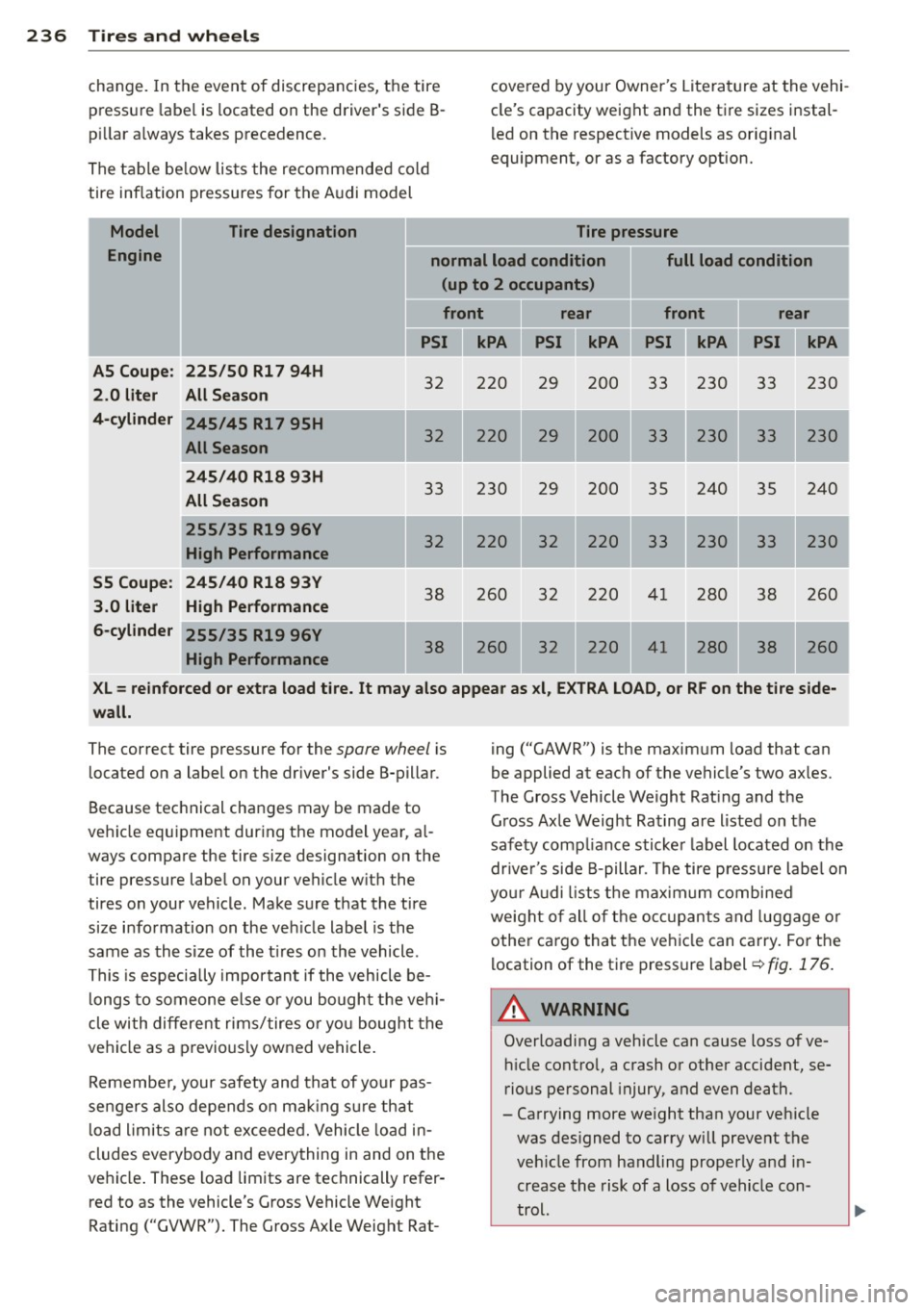
236 Tires and wheels
change. In the event of discrepancies, the tire
pressure labe l is located on the driver's side B
p ill ar a lways takes precedence.
The table below lis ts the recommended cold
tire inflation pressures for the Audi model
I Model II
Tire designation
covered by your Owner's Literature at the vehi
cle's capacity weight and the tire sizes instal
l ed on the respective models as orig inal
equipment, or as a factory option.
Tire pressure
Engine normal load condition full load condition
(up to 2 occupants)
front rear front rear
I
PSI Jl kPA PSI Jl kPA PSI Jl kPA PSI Jl kPA
AS Coupe: 225/50 R17 94H
2.0 liter All Season
4-cylinder 245/45 Rl 7 95H
I Au Season
245/40 R18 93H
All Season
2SS /35 R19 96V
High Performance
55 Coupe: 245/40 R18 93V
3 .0 liter High Performance
6-cylinder
-255/35 R19 96V
High Performance
32 220
32 220
33 230
32 220
38 260
38
260
29 200 33 230 33 230
.
29 200 33 230 33 230
I
29 200 35 240 35 240
'
32 220 33
230 33 230
I
32 220 41 280 38 260
32 220 41 280 38 260
I
XL= reinforced or extra load tire. It may also appear as xl, EXTRA LOAD, or RF on the tire side
wall.
The correct tire pressure for the spare wheel is
located on a label on the driver's side B-pillar.
Because technical changes may be made to
vehicle equipment during the model year, a l
ways compare the tire size designation on the
tire pressure label on your vehicle with the
tires on your vehicle . Make sure that the tire
size information on the veh icle label is the
same as the size of the t ires on the vehicle .
This is especially important if the vehicle be
lo ngs to someone else or you bought the veh i
cle with different rims/tires o r you bought the
vehicle as a previously owned vehicle .
Remember, your safety and that of your pas
sengers also depends on mak ing sure that
l oad limits are not exceeded. Vehicle load in
cludes everybody and everything in and on the
vehicle . These load limits are technically refer
red to as the vehicle's Gross Vehicle Weight
Rating ("GVWR"). The Gross Axle Weight Rat- ing
("GAWR") is the maximum load that can
be applied at each of the vehicle's two axles.
The Gross Vehicle Weight Rating and the
G ross Axle Weight Rating are listed on the
safety comp liance sticker label located on the
drive r's side B-pillar . The tire pressure label on
your Audi lists the maximum combined
weight of all of the occupa nts and luggage or
other cargo that the vehicle can carry. For the
location of the tire pressure label¢
fig. 176.
A WARNING ._
Overloading a vehicle can cause loss of ve
hicle contro l, a crash or other accident, se
rious personal injury, and even death.
- Carrying more weight than your vehicle
was designed to carry will prevent the
veh icle from handling properly and in
crease the risk of a loss of vehicle con
trol.
Page 244 of 294
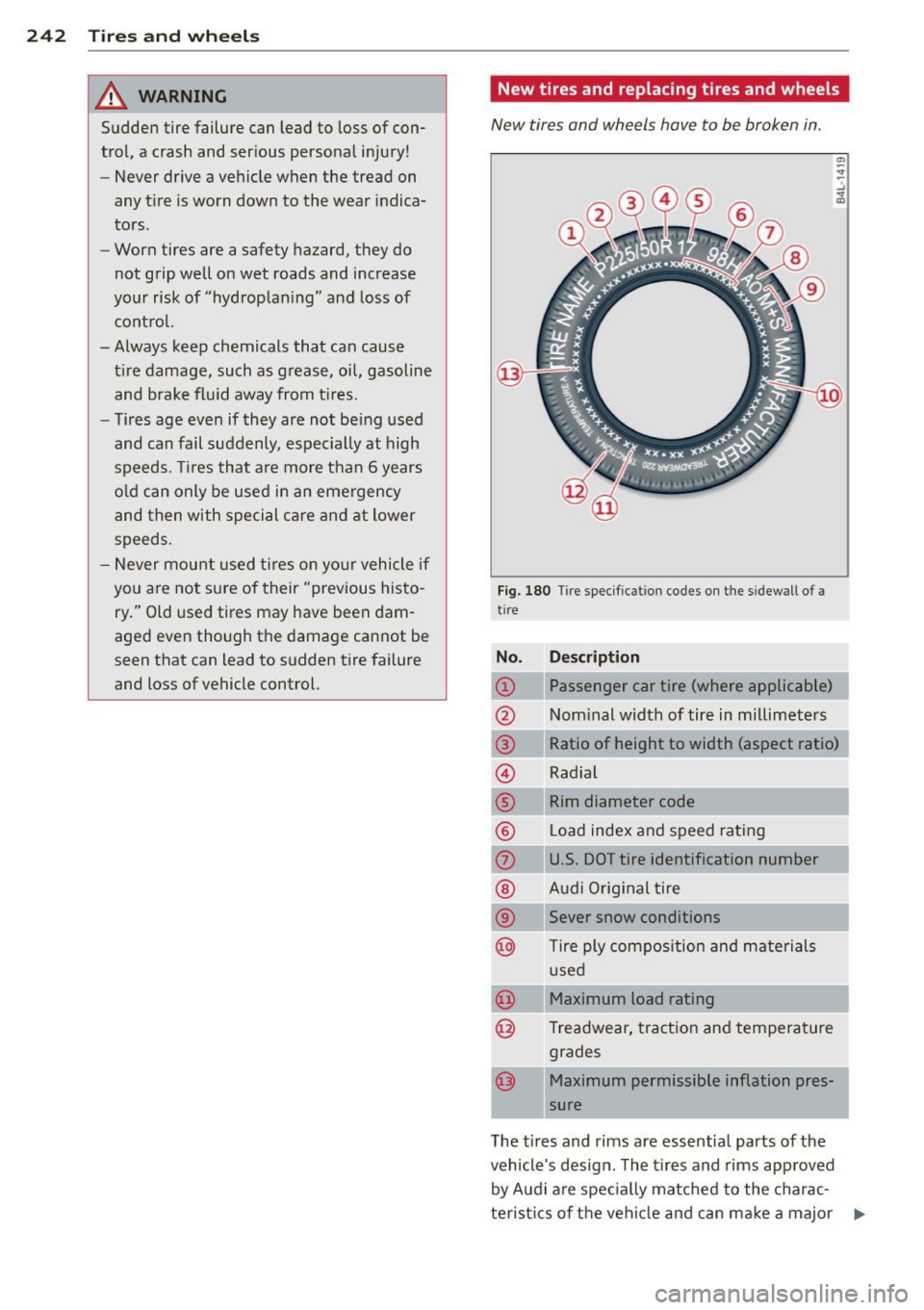
242 Tires and wheels
& WARNING
Sudden tire failure can lead to loss of con
trol, a crash and serious persona l injury!
- Never drive a vehicle when the tread on
any tire is worn down to the wear indica
tors.
- Worn tires are a safety hazard, they do
not grip well on wet roads and increase
your risk of "hydroplaning" and loss of control.
- Always keep chemicals that can cause tire damage, such as grease, oil, gasoline
and brake fluid away from tires.
- Tires age even if they are not be ing used
and can fail suddenly, especially at high
speeds. Tires that are more than 6 years
old can only be used in an emergency
and then with special care and at lower
speeds.
- Never mount used tires on your vehicle if
you are not sure of their "previous histo
ry." Old used tires may have been dam
aged even though the damage cannot be
seen that can lead to sudden tire failure
and loss of vehicle control.
New tires and replacing tires and wheels
New tires and wheels have to be broken in .
Fig. 180 Tir e specificat ion codes on the s idewall of a
t ire
No. Description
(!) Passenger car tire (where applicable)
@ Nominal width of tire in millimeters
@ Ratio of height to width (aspect ratio)
© Radial
® Rim diameter code
@ Load index and speed rating
(J) U.S. DOT tire identification number
@ Audi Orig inal tire
@ Sever snow conditions
@ Tire ply composition and materials
used
Maximum load rating
Treadwear, traction and temperature
grades
Maximum permissible inflation pres
sure
T he tires and rims are essential parts of the
vehicle 's design . The tires and rims approved
by Audi are spec ially matched to the charac
teristics of the vehicle and can make a major .,..
Page 246 of 294
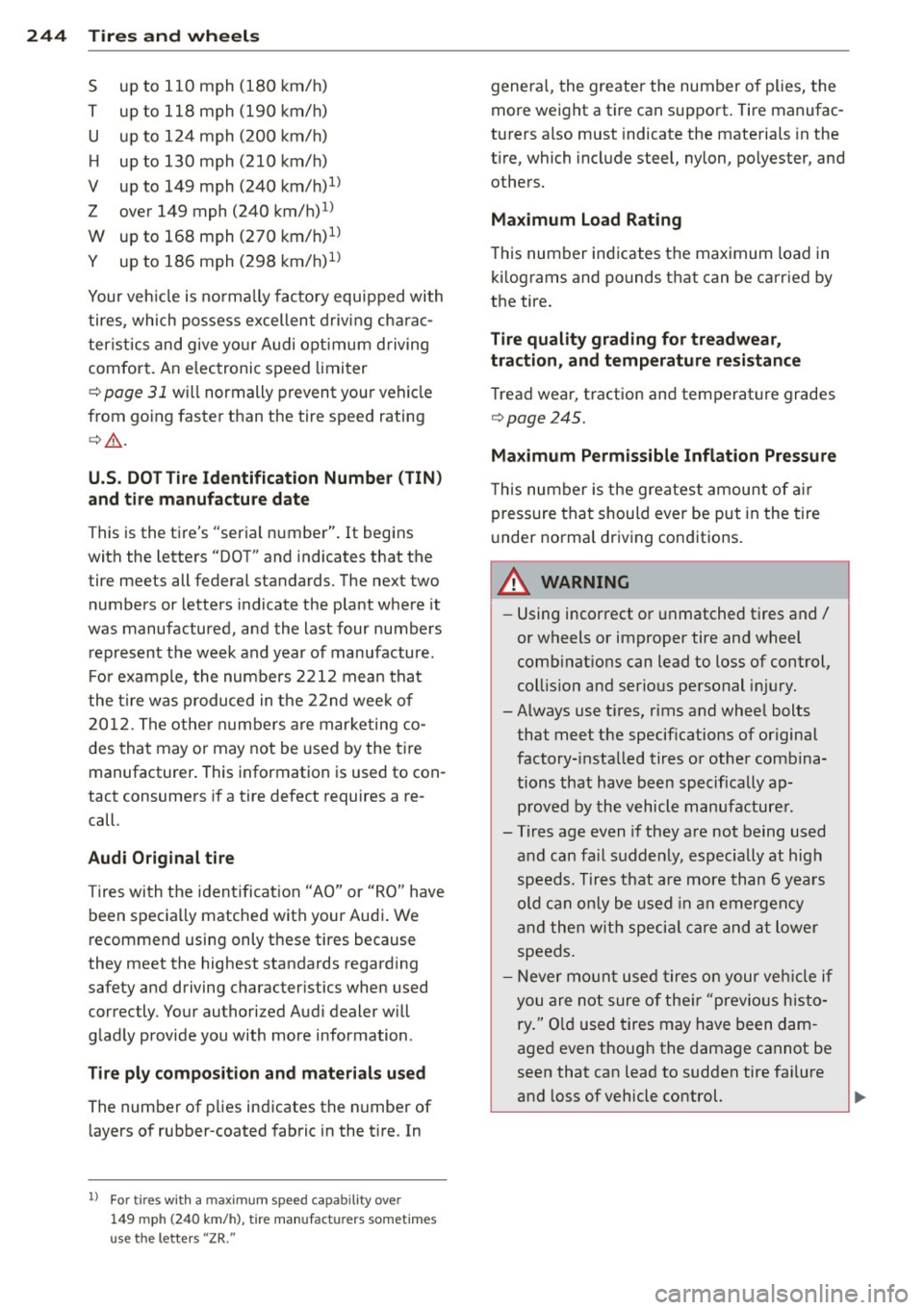
24 4 T ire s and wheel s
S up to 110 mph (180 km/h)
T up to 118 mph (190 km/h)
U up to 124 mph (200 km/h)
H up to 130 mph (210 km/h)
V up to 149 mph (240 km/h)1l
Z over 149 mph (240 km/h)ll
W up to 168 mph (270 km/h)ll
Y up to 186 mph (298 km/h)
1 l
Your veh icle is no rma lly factory equipped with
tires, which possess excellent driving cha rac
terist ics and give yo ur Audi opt imum d riving
comfort . An e lectronic speed limiter
c::> page 31 will normally prevent your vehicle
from going faster than the tire speed rating
¢ &. .
U.S. DOT Ti re Identification Numb er (TIN)
and ti re manuf actur e date
This is the tire's "serial number" . It begins
with the letters "DOT" and indicates that the
tire meets all federal standards. The next two
numbers or letters indicate the plant where it
was manufactured, and the last four numbers
represent the week and year of manufacture.
For example, the numbers 2212 mean that
the tire was produced in the 22nd wee k of
2012. The other n umbers are mar keting co
des that may or may not be used by the tire
manufacturer . This information is used to con
tact consumers if a tire defect requires a re
call.
Audi Original tir e
Tires with the identification "AO" or "RO" have
been specia lly matched with your Audi . We
recommend using only these tires because
they meet the highest standards regard ing
safety and driving character istics when used
correctly. Your authorized Audi dealer will
glad ly provide you with more information.
Tire ply compo sit ion and materi als used
The number of plies indicates the number of
l ayers of rubber-coated fabric in the tire. In
ll For tir es w it h a m ax im um spee d ca pabil ity ove r
1 4 9 mp h (2 40 k m/h) , t ire man ufact urers somet imes
u se the letters "ZR. "
genera l, the greater the number of plies, the
more weight a tire can support. Tire manufac
turers also must indicate the mate rials in the
t ire, which include steel, nylon, po lyester, and
others.
Ma ximum Load Rating
This number ind icates the maximum load in
ki lograms and pounds that can be carried by
the tire.
Tire quality grading for treadwear ,
traction , and t emp eratu re resi stance
T read wear, t raction and temperat ure grades
c::> page
245.
Ma ximum Permi ssible Inflat ion Pressure
T h is number is the greatest amount of a ir
pressure that should ever be put in the tire
u nder norma l driving cond itions.
.&, WARNING ~ -
- Using incorrect or unmatched tires and/
or wheels or improper tire and wheel
comb inat ions can lead to loss of control ,
coll is ion and serious personal injury.
-Always use t ires, rims and whee l bolts
that meet the specifications of original
factory- installed tires or other combina
tions that have been specifically ap
p roved by the vehicle manufacture r.
- Tires age even if they are not being used
and can fail suddenly, especially at high
speeds. Tires that are more than 6 yea rs
old can only be used in an emergen cy
a nd then w it h specia l care and at lower
speeds.
- Never mo unt used tires on your veh icle if
you are no t sure of the ir "previo us histo
ry." O ld used tires may have been dam
aged even though the damage cannot be
seen that can lead to sudden tire fa ilure
and loss of vehicle control.
Page 247 of 294

-All four wheels must be fitted with radial
tires of the same type, size (rolling cir
cumference) and the same tread pattern .
Driving with different tires reduces vehi
cle handling and can lead to a loss of
control.
- If the spare tire is not the same as the
tires that are mounted on the vehicle -
for example with winter tires -only use
the spare tire for a short period of time and drive with extra care. Refit the nor
mal road wheel as soon as safely possi
ble.
- Never drive faster than the maximum
speed for which the tires on your vehicle
are rated because tires that are driven
faster than their rated speed can fail
suddenly.
- Overloading tires cause heat build-up,
sudden tire failure, including a blowout
and sudden deflation and loss of control.
- Temperature grades apply to tires that
are properly inflated and not over or un
derinflated .
- For technical reasons it is not always
possible to use wheels from other
vehicles -in some cases not even wheels
from the same vehicle model.
- If you install wheel trim discs on the ve
hicle wheels, make sure that the air flow
to the brakes is not blocked. Reduced air
flow to the brakes can them to overheat,
increasing stopping distances and caus
ing a collision.
- Run flat tires may only be used on
vehicles that were equipped with them at the factory. The vehicle must have a
chassis designed for run flat tires and a
factory-installed tire pressure monitor ing system* that indicates a loss of tire
pressure. Incorrect use of run flat tires
can lead to vehicle damage or accidents.
Check with an authorized Audi dealer or
tire specialist to see if your vehicle can be
equipped with run flat tires .
If run flat
tires are used, they must be installed on
all four wheels. Mixing tire types is not
permitted.
Tires and wheels 245
@ Note
- For technical reasons, it is not generally
possible to use the wheel rims from oth
er vehicles. This can hold true for wheels
of the same vehicle type.
- If the spare tire is different from the
tires that you have mounted on your ve
hicle (for example winter tires or wide
profile tires), then use the spare tire for a
short period of time only and drive with
extra care. Replace the flat tire with the
tire matching the others on your vehicle
as soon as possible.
- Never drive without the valve stem cap .
The valves could get damaged.
(® For the sake of the environment
Dispose of old tires in accordance with the
local requirements.
Uniform tire quality grading
- Tread wear
- Traction AA A B C
- Temperature ABC
Quality grades can be found where applicable
on the tire side wall between tread shoulder
and maximum section width
c:> page 242,
fig. 180 .
For example: Tread wear 200, Traction AA,
Temperature A.
All passenger car tires must conform to Feder
al Safety Requirements in addition to these
grades.
Tread wear
The tread wear grade is a comparative rating
based on the wear rate of the tire when tested
under controlled conditions on a specified
government test course.
For example, a tire graded 1S0 would wear
one and one half (1 1/2) times as well on the
government course as a tire graded 100.
1JJ>
•
•
Page 250 of 294

248 Tires and wheels
driving a few yards and correct if neces
sary. Follow the instructions from the
snow cha in manufacturer when doing so.
(D Tips
Where snow chains are mandatory oncer
tain roads, this normally also applies to
vehicles with all wheel drive.
Wheel bolts
Wheel bolts must always be tightened to the
correct torque.
The design of whee l bolts is matched to the
factory installed rims. If different rims are fit
ted, the correct wheel bolts with the right length and correctly shaped bolt heads must
be used. This ensures that wheels are fitted
securely and that the brake system functions
correctly .
In certain circumstances, you may not use
wheel bolts from a different vehicle -even if it
is the same model
¢ page 275.
.&_ WARNING
Improperly tightened or maintained wheel
bolts can become loose causing loss of
control, a collision and serious persona l in
Jury.
- Always keep the wheel bolts and the
threads in the wheel hubs clean so the
wheel bolts can turn easily and be prop
erly tightened.
- Never grease or oil the wheel bolts and
the threads in the wheel hubs. They can
become loose while driving if greased or
oiled, even if tightened to the specified
torque.
- Only use wheel bolts that belong to the
rim being installed.
- Never use different wheels bolts on your
vehicle.
- Always maintain the correct tightening
torque for the wheel bolts to reduce the
risk of a wheel loss . If the tightening tor
que of the wheel bolts is too low, they
can loosen and come out when the veh i- cle
is moving.
If the tightening torque is
too high, the wheel bolts and threads
can be damaged and the wheel can be
come loose.
(D Note
The specified torque for the whee l bolts is
90 ft lbs . (120 Nm) with a tolerance of
± 7,4 ft lbs. (± 10 Nm). Torque wheel bolts
diagonally . After changing a wheel, the
torque must be checked as soon as possi
ble with a torque wrench -preferably by an
authorized Audi dealer or qualified work
shop.
Low aspect ratio tires
Your Audi is factory -equipped with low aspect
ratio tires. These tires have been thoroughly
tested and been se lected specifically for your
model for their superb performance, road feel
and handling under a variety of driving condi
t ions . Ask your authorized Audi dealer for
more details .
The low aspect ratio of these tires is indicated
by a numeral of
55 or less in the tire's s ize
designation . The numeral represents the ratio
of the tire's sidewall height in relation to its
tread width expressed in percentage. Conven
tional tires have a height/w idth rat io of 60 or
more.
The performance of low-aspect-ratio tires is
particularly sensitive to improper inflation
pressure. It is therefore important that low
aspect ratio tires are inflated to the specified
pressure and that the inflation pressure is
regularly checked and maintained. Tire pres
sures should be checked at least once a
month and always before a long trip
¢ page 237, Checking tire pressure.
What you can do to avoid tire and rim
damage
Low aspect ratio tires can be damaged more
easily by impact with potholes, curbs, gul lies
or ridges on the road, particularly if the tire is
underinflated . ..,.
Page 260 of 294
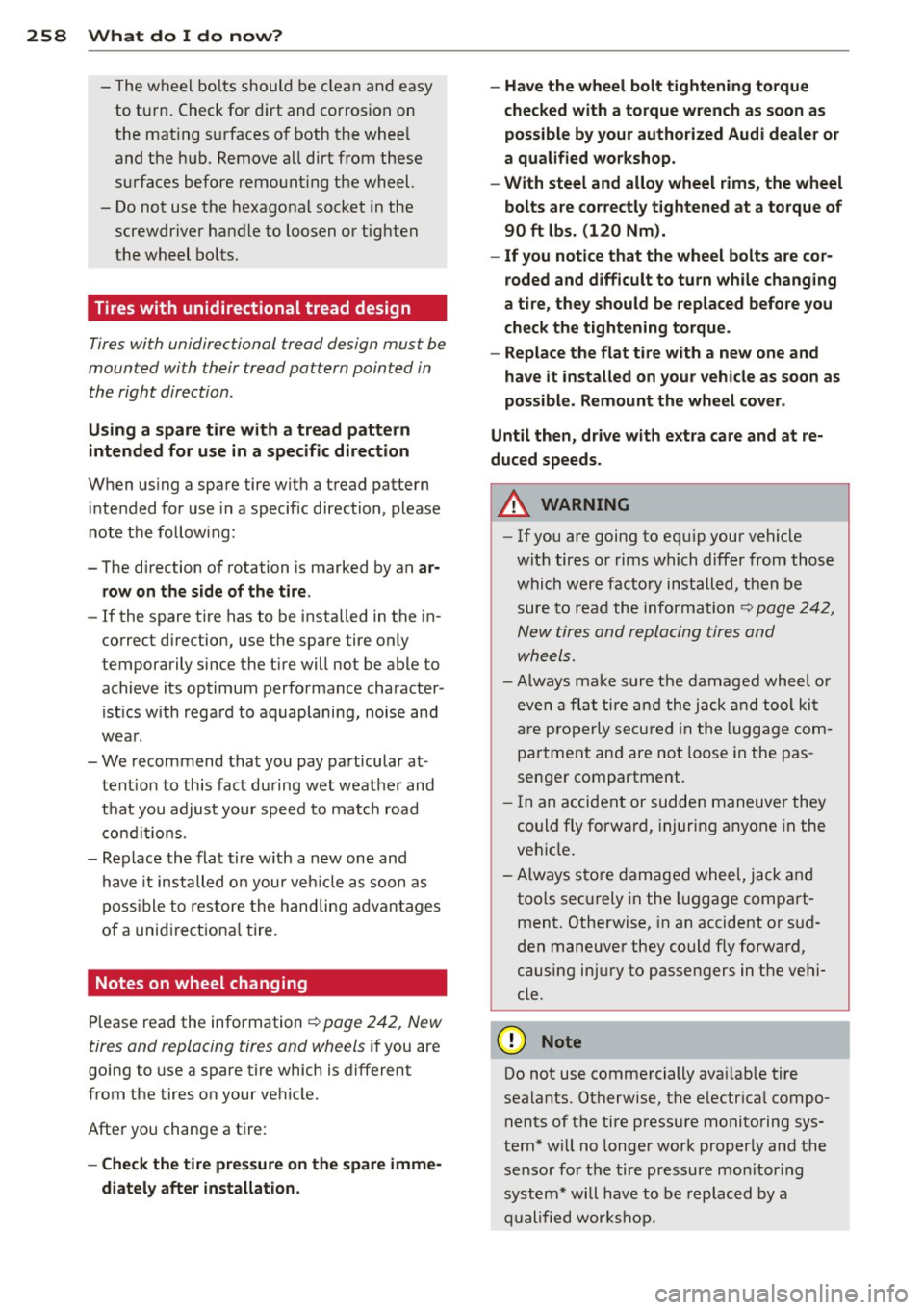
258 What do I do now?
-The w heel bolt s should be clea n and easy
to tu rn. Check for dirt and corrosion on
t h e mat ing s urfaces o f both the whee l
and the h ub. Remove a ll dirt from these
su rfaces befor e remo unt ing the wheel.
- Do no t use the hexagona l socket in the
screwdriver handle to l oosen o r ti gh ten
t h e wheel bo lts .
Tires with unidirectional tread design
Tires with unidirectional tread design must be
mounted with their tread pattern pointed in the right direction .
Using a spare tire with a tread pattern
intended for use in a specific direction
When using a spare tire w it h a t read patte rn
in te nded for use in a specific direction, p lease
n ote t he follow ing:
- The direction of rotation is marked by an
ar
row on the side of the tire .
-If the spare t ire has to be installed in the in
correct d irection, use the spare tire only
temporarily si nce the t ire will not be able to
achieve its optimum perfo rma nce character
ist ics w ith r ega rd to aquaplani ng, noise and
wea r.
- We recommend tha t you pay particular at
tent io n to this fact du ring wet weathe r and
t h at you a djust your spee d to matc h roa d
condition s.
- Re place the fla t tire w ith a n ew on e and
h av e it installed o n your ve hicle as soon as
p ossib le to res tore the ha nd ling ad vantages
o f a un idirect ional t ire.
Notes on wheel changing
Please rea d the information c::> page 242, New
tires and replacing tires and wheels
if you are
go ing t o use a spare t ire which is different
from the tires on your ve hicle.
Afte r you change a tire :
-Check the tire pressure on the spare imme
diately after installation. -
Have the wheel bolt tightening torque
checked with a torque wrench as soon as
possible by your authorized Audi dealer or
a qualified workshop.
- With steel and alloy wheel rims, the wheel
bolts are correctly tightened at a torque of
90 ft lbs. (120 Nm).
- If you notice that the wheel bolts are cor ·
roded and difficult to turn while chang ing
a tire , they should be replaced before you
check the tightening torque .
- Replace the flat tire w ith a new one and
have it installed on your vehicle as soon as
possible. Remount the wheel cover.
Until then, drive with extra care and at re·
duced speeds.
A WARNING ..__ -
- If you are going to equ ip your ve hicle
wit h tir es o r rims which differ from th ose
which w ere fac tory i nstalled, then be
s ure to read the information
c::> pag e 242 ,
N ew t ires and repl acin g tires and
wheels.
- Always make sure the dam age d wheel o r
eve n a flat tire and t he jack and to ol kit
a re p roperly secu red in the lugg age com
p art ment and are no t loose in the pas
sen ger compartment.
- In an a cci dent or sudde n maneuver they
co uld fly forwa rd, in juring a nyone in the
veh icle.
- Always s to re damage d whee l, jack an d
too ls sec urely in the l ugga ge com pa rt
ment. Othe rwise, in a n accide nt or s ud
den maneuver they co uld f ly forwa rd,
causing inj ury to passe ngers in the ve hi
cle .
(I) Note
Do not use comme rcially ava ilab le tire
sea lants. Ot herwise , th e e lectr ica l comp o
nents of the tire pressu re monitoring sys
tem* w ill no longe r work pr oper ly and th e
se nso r fo r th e tire pressure moni tor ing
syst em* will have to be repla ced by a
qu alifie d w ork s hop .
Page 289 of 294
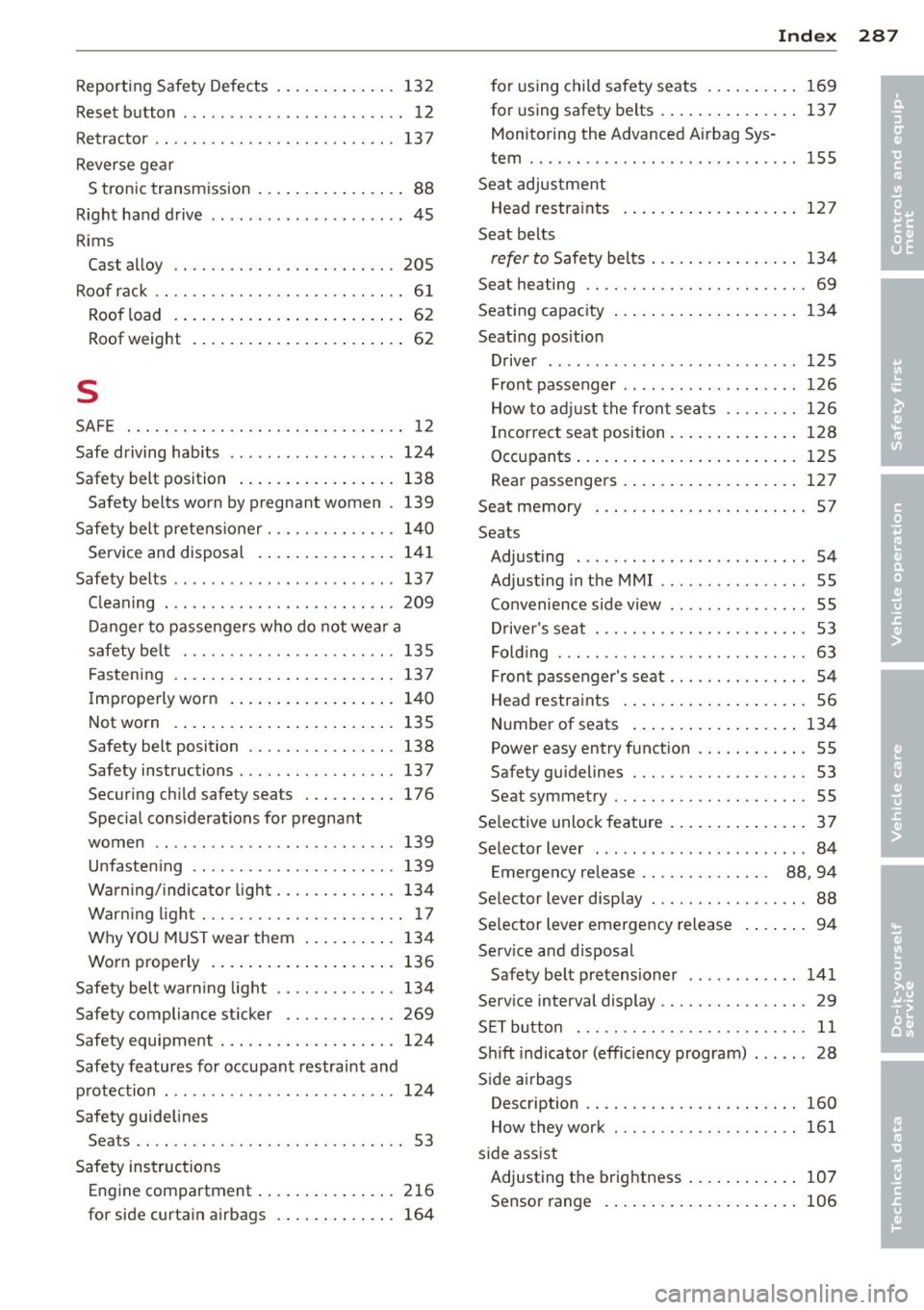
Reporting Safety Defects .......... .. . 132
Reset button . . . . . . . . . . . . . . . . . . . . . . . . 12
Retractor .. .. ............. .... .. .. . 137
Reverse gear S tronic transmission ............ .. .. 88
Right hand drive ............ ...... ... 45
Rims Cast alloy .. ............. .... .. ... 205
Roof rack ........................... 61
Roof load . . . . . . . . . . . . . . . . . . . . . . . . . 62
Roof weight . . . . . . . . . . . . . . . . . . . . . . . 62
s
SAFE ... .. .. .. ................ ... .. 12
Safe driving habits ................ .. 124
Safety belt position . . . . . . . . . . . . . . . . . 138
Safety belts worn by pregnant women . 139
Safety belt pretens ioner . . . . . . . . . . . . . . 140
Service and disposal ......... ... .. . 141
Safety belts . . . . . . . . . . . . . . . . . . . . . . . . 13 7
Cleaning . .. .. ... ....... .... ... .. . 209
Danger to passengers who do not wear a
safety belt . .... ......... .... .. .. . 135
F astening . ................. ... ... 137
Improp erly worn ............ ... .. . 140
Not worn .. .. .............. ... ... 135
Safety belt position . . . . . . . . . . . . . . . . 138
Safety instructions .......... .. .. .. . 13 7
Securing child safety seats .......... 176
Special considerations for pregnant
women .. .. .. .... ........ ... .. .. . 139
Unfastening .. .. ......... .. .. .. ... 139
Warn ing/ indicator light ............. 134
Warn ing light ............ .... .. .. .. 17
Why YOU MUST wear them .......... 134
Worn properly .............. ... .. . 136
Safety belt warning light ............. 134
Safety compliance sticker ..... .. .. .. . 269
Safety equipment .................. . 124
Safety features for occupant restraint and protection . ................ ...... .. 124
Safety guidelines Seats .. .. .. ................. .. .... 53
Safety instructions Engine compartment ......... ... .. . 216
for side curtain airbags ..... ... .. .. . 164
Index 287
for using child safety seats ......... . 169
for using safety belts .............. . 137
Monitoring the Advanced Airbag Sys-
tem ............................. 155
Seat adjustment Head restraints
Seat belts 127
refer to Safety belts ... ......... .. .. 134
Seat heating . . . . . . . . . . . . . . . . . . . . . . . . 69
Seating capacity ..... .............. . 134
Seating position Driver ................. .......... 125
Front passenger .. .. . .......... .... 126
How to adjust the front seats ........ 126
Incorrect seat position .............. 128
Occupants ........................ 125
Rear passengers .. .. .............. . 127
Seat memory . .. .. ................. . 57
Seats Adjusting . . . . . . . . . . . . . . . . . . . . . . . . . 54
Adjusting in the MMI .......... .... .. 55
Convenience side view . . . . . . . . . . . . . . . 55
Drive r's seat . . . . . . . . . . . . . . . . . . . . . . . 53
Folding . .... .. .... ... .......... .. . 63
Front passenger's seat . . . . . . . . . . . . . . . 54
Head restraints .... .............. .. 56
Number of seats ... .............. . 134
Power easy entry function ............ 55
Safety guidelines . ............. .. .. . 53
Seat symmetry . . . . . . . . . . . . . . . . . . . . . 55
Selective unlock feature ............... 37
Selector lever . . . . . . . . . . . . . . . . . . . . . . . 84
Emergency release . . . . . . . . . . . . . . 88, 94
Selector lever display ................ . 88
Selector lever emergency release . . . . . . . 94
Service and disposal Safety be lt pretensioner ............ 141
Service interval display . . . . . . . . . . . . . . . . 29
SET button . . . . . . . . . . . . . . . . . . . . . . . . . 11
Shift indicator (efficiency program) ...... 28
Side airbags Description .. .. .. .. ............... 160
How they work . .. .... ......... .. .. 161
side assist Adjusting the brightness ............ 107
Sensor range .... .. ............... 106
•
•